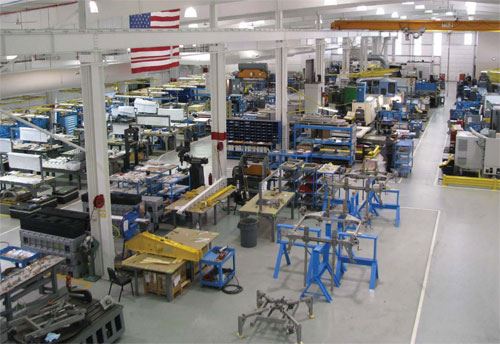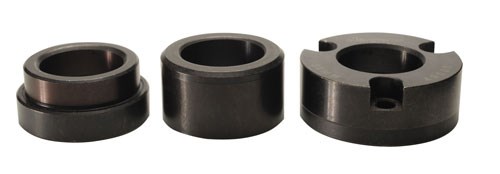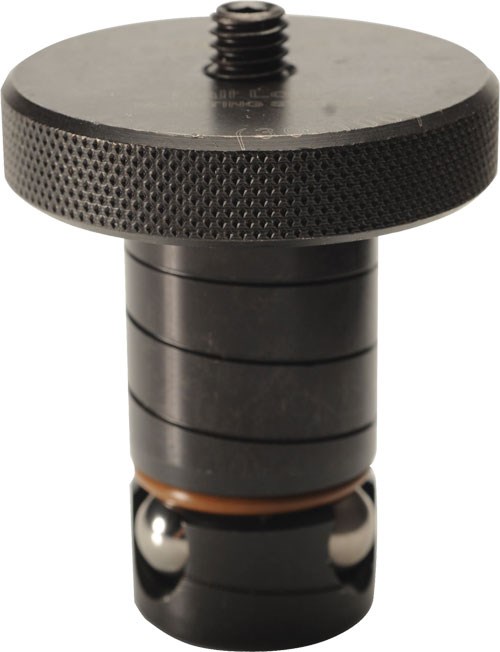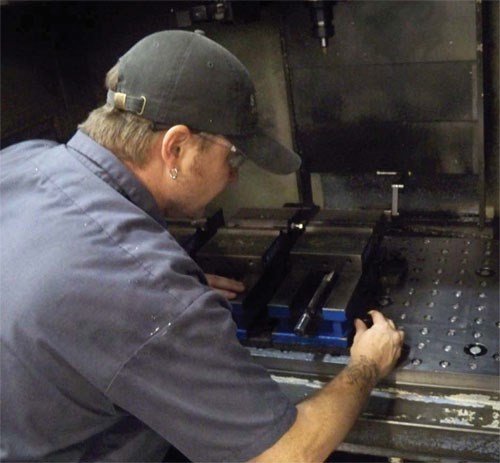Even if no specific pre-machining bottlenecks can be identified, time spent performing multiple setups on multiple workstations can compound quickly and adversely affect the bottom line. This is especially true for job shops, which are often faced with producing a variety parts in a range of quantities.
Military support system manufacturer Seyer Industries is no job shop, but it nonetheless faces similar challenges, says Mark Seyer, manufacturing manager. “While we see some jobs with hundreds of parts or even thousands, we’re not a high-production operation,” he explains. “We’ve got to be very flexible because we also see a lot of smaller quantities, typically in the 10- to 25-piece range.”
One recent equipment investment has been particularly effective at addressing challenges with setup flexibility, Mr. Seyer says. Installed in 2009, the Ball Lock quick-change fixturing system from Jergens, Inc. (Cleveland, Ohio) enables operators to quickly and easily change-over all the company’s VMCs as needed to accommodate different jobs. As a result, Seyer has reduced setup times by 20 to 50 percent, depending on the part. Ball Lock has also contributed additional, unexpected benefits, namely reduced scrap and improved machining accuracy.
Founded in 1957, Seyer Industries is a third-generation, family-owned business based in St. Peters, Missouri. At its four-facility campus, which totals more than 80,000 square feet of floor space, the company designs and manufactures ground support equipment, training and simulation systems, aircraft subsystems and other defense-industry components, primarily for the aerospace sector. In addition to supplying such customers as Boeing, Pratt & Whitney and Lockheed Martin Corporation, Seyer often contracts directly with the military. In-house capabilities include CNC machining, assembly, design engineering, painting, kitting and welding.
Seyer has been working to implement lean principles since 1999. As part of its continuous improvement and waste reduction efforts, the company regularly conducts Accelerated Improvement Workshops (AIWs) focused on particular aspects of its operations. “We identify something we can improve in the shop, and then we spend a week or so with representatives from different departments to try and find a better way to do it,” Mr. Seyer explains. “AIWs aren’t just free-thinking or brainstorming—we’ll actually sit with the operator and use a stop watch to identify which particular procedures take the most time so we can focus on those aspects.”
In 2009, the company conducted a workholding-focused AIW in order to identify ways to reduce setup time. Coincidentally, a Jergens, Inc. representative held a seminar on the Ball Lock system at a local manufacturing facility around that same time. Mr. Seyer attended, and he was intrigued enough to further investigate the system and run a few tests. Initially, the company configured two of its 24 CNC machining centers to accommodate the system. Shortly thereafter, significant time and cost savings on those two machines led Seyer to outfit every VMC on the shop floor to work with Ball Lock. (As for the company’s HMCs, Mr. Seyer says the number of changeovers was insufficient to justify the investment.)
At the core of the Ball Lock system are three components: shanks, liners and receiver bushings. Each shank inserts through a liner mounted on a fixture plate and into a receiver bushing mounted in a subplate on the machine table. Clamping is achieved via three locking balls arranged around the inside perimeter of the bottom end of each shank. A larger fourth ball, the actuating ball, is situated above the three locking balls. Twisting a screw at the top of the shank pushes the actuating ball downward into the three locking balls, forcing them outward into a tapered groove in the receiver bushing.
According to the developer, the system enables users to accurately lock and locate in the same motion, as long as the liners and receiver bushings are positioned correctly. No wrenches or other tools are necessary for clamping because the shanks’ turning screws are tightened by hand. Moreover, with repeatability of ±0.0005 inch (±0.013 mm), the system minimizes the need to indicate fixtures. Each shank exerts as much as 20,000 lbs (9,000 kg) of clamping force.
Jergens offers everything a manufacturer would need to get started with the system, including fixture plates, subplates and tooling columns with pre-installed receiver bushings and liners as well as vises designed specifically to work with the system. Also available are Ball Lock “kits” that are configured for specific machine models.
However, Seyer Industries took a different route, opting to retrofit its machines and workholding devices in-house to accommodate the quick-change system. This involved drilling and reaming holes in its own grid plates to accommodate the receiver bushings and mounting each of its existing vises on its own subplate, complete with liners. “We really didn’t change anything we did before, except the loading and unloading of our vises got a lot quicker and easier,” Mr. Seyer says.
The process of outfitting its own equipment was eased somewhat by the fact that all of the company’s VMCs use grid plates with 2-by-2-inch hole patterns. Nonetheless, it still took a few months to retrofit the grid plates to accommodate the receiver bushings. While that’s primarily because the company had to keep churning out parts in the meantime, precision was also a concern. “You can only be as accurate as the table is, so we really wanted to take our time and make sure we did it right,” Mr. Seyer says.
In fact, the company discovered during this process that the grid plates on its VMCs’ tables weren’t as accurate as previously believed. This turned out to be an unexpected side benefit of Ball Lock implementation. After adjustments, the plates are now accurate to within a few “tenths,” as opposed to a few thousandths previously.
Ball Lock is employed for a large percentage of the company’s jobs—“pretty much anything besides round and sheet stock that we need to put in a vise fixture,” Mr. Seyer says. The system has provided the greatest benefit for the company’s longer setups, which are typically those that involve mounting multiple vises in a line. For example, a part might be machined on one side in the first vise, then moved to the second for machining of another side. Meanwhile, a new blank would be loaded in the first vise, and so on.
Pre-Ball Lock, each vise would have to be indicated separately to find a zero location, a process that could take approximately 30 minutes for each fixture, Mr. Seyer says. Now, the company can be more confident that all vises are properly in line and within tolerance once mounted to the grid plate. Mounting is fast and easy thanks to the system’s ability to locate and secure the fixture simultaneously, he adds, especially because the shanks can be tightened by hand as opposed to using a wrench.
However, some indicating is still required. “When you’re working in the thousandths of an inch, you’re still going to be double-checking to make sure it’s in line, but it’s definitely faster, ” Mr. Seyer says. “Before we might have been within 10 or 15 thousandths, but with Ball Lock we’re always within only a couple of thousandths. When we do need to make adjustments, they are a lot smaller—we’re usually right on the first time or at least within tolerance.”
He estimates that setup time savings range from 20 percent for a single vise and as much as 50 percent for four or more vises. Of course, Ball Lock’s benefits extend beyond just single-machine setups because all the company’s VMCs use the same 2-by-2-inch, retrofitted grid plate. This makes it fast and easy to transfer a fixture from one workstation to another.
While by far the most significant, easier change-overs and faster setups aren’t the only benefits provided by the quick-change system. “Our scrap rate is definitely less since we implemented Ball Lock,” Mr. Seyer notes. “The system’s accuracy makes it less likely that we’ll be out of tolerance and scrap parts due to misaligned vises or other fixturing issues. Between that and the setup time savings, it’s more than paid for itself.”

























.jpg;maxWidth=300;quality=90)



















